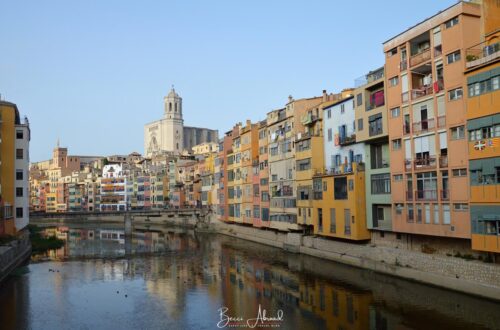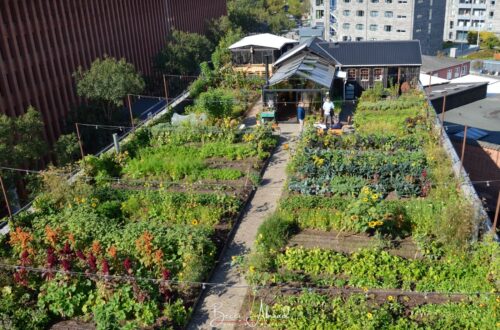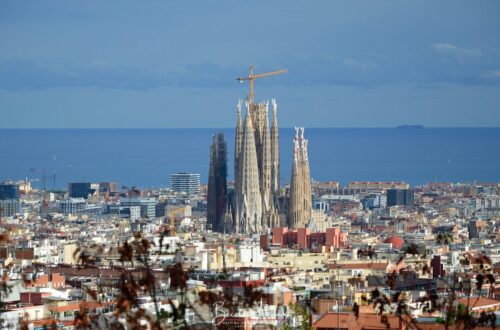20 Popular Places to Visit in Barcelona, Spain
Barcelona is one of the most popular travel destinations in Europe. The all-year-round mild climate, world-famous architecture, easy beach access, and many great options for shopping and cool restaurants in Barcelona make the city a top destination for many people.
But Barcelona can also be a bit overwhelming!
There are so many popular places to visit in Barcelona! It can be hard to keep track of them all, not to mention choose which ones to visit once you visit the Catalan capital!
If you are traveling to Barcelona for the first time and feel a bit overwhelmed by this famous European destination, then this post is for you!
Whether visiting Barcelona with friends or traveling to Spain solo, this post covers the 20 must-visits you cannot miss in Barcelona!
After 2 years of living in Barcelona, I have visited most of the popular places – and, of course, a lot of hidden gems in Barcelona.
Let’s get started with the best of Barcelona!
An Expat’s Guide to the 20 Most Popular Places to Visit in Barcelona
Disclosure: Some of the links below are affiliate links. This means that at no additional cost to you, Becci Abroad will earn a commission if you purchase through one of those links. This helps to pay the bills and the maintenance of the site.
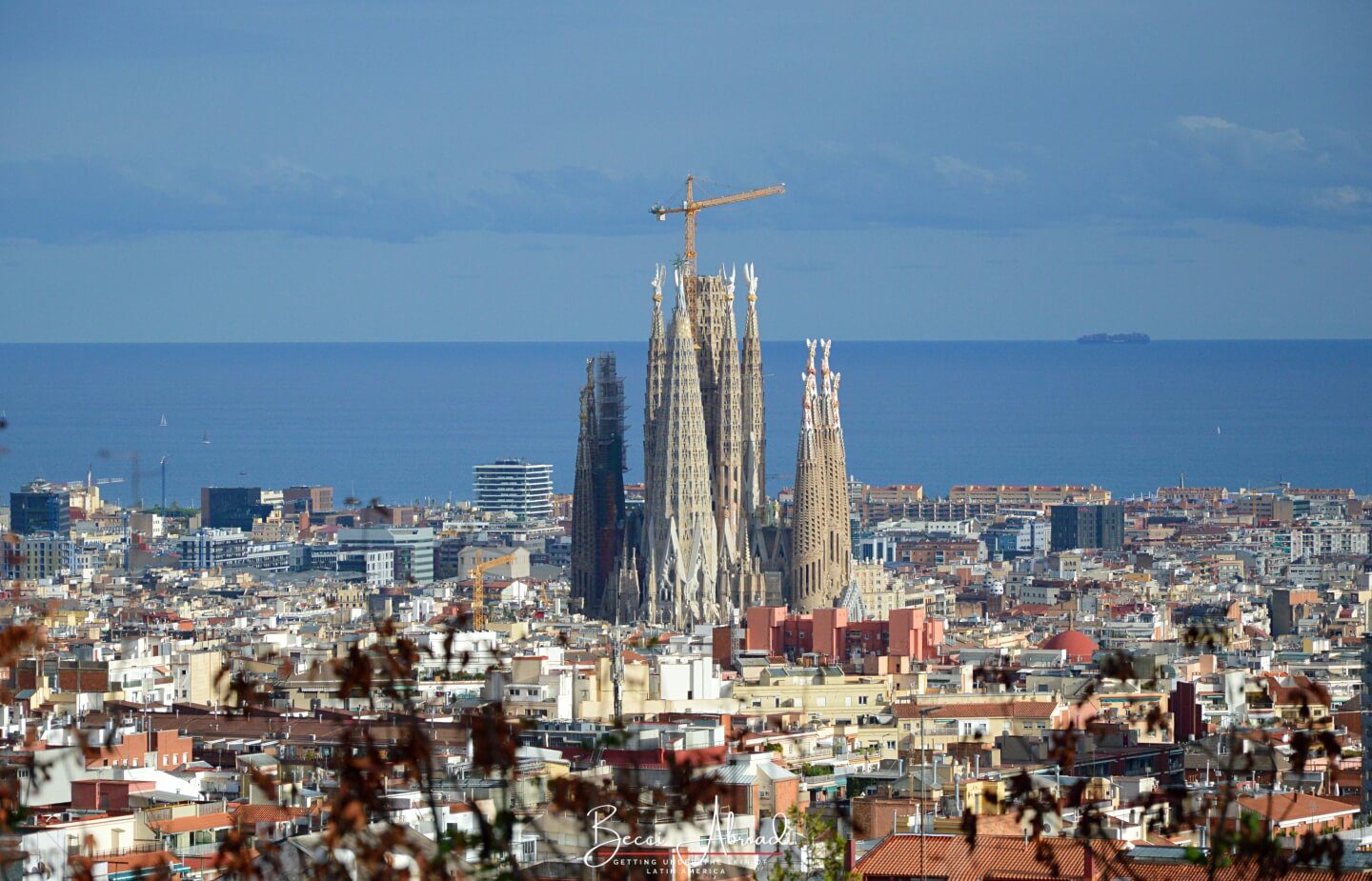
The 20 Best Places to Visit in Barcelona for First-Timers
Barcelona is a popular city break destination in Europe, and here are the 20 Best Places to Visit in Barcelona when you visit for the first time.
Sagrada Familia
The Sagrada Familia is one of those places to visit in Barcelona that you can’t miss!
The basilica is considered to be Barcelona’s most iconic landmark, and a Catalan Art Nouveau-style masterpiece without comparison!
The Sagrada Familia was designed by the famous Catalan architect Antonio Gaudi. The construction began in 1882 and remains unfinished to this day with the central tower yet to be completed. This makes it the largest unfinished Roman Catholic Church.
If you are planning to visit Sagrada Familia during your trip to Barcelona (you definitely should!), then make sure to secure your visit by reserving tickets in advance. Since Sagrada Familia is an extremely popular tourist attraction in Barcelona, the entrances quickly get booked out.
The standard entrance ticket to Sagrada Familia includes access to the Sagrada Familia app, which offers an audioguide for your visit at no additional cost. The audio guide provides information about the basilica, including Gaudi’s design concepts and the history of the Sagrada Familia’s development.
If you want to do the audioguide, you must remember to bring your headphones and download the app before you start your visit. Instead of doing the audio guide, you can also do a guided tour of Sagrada Familia.
Get the perfect shot of the Sagrada Familia by checking out the two parks flanking the basilica for the ultimate view from ground level!
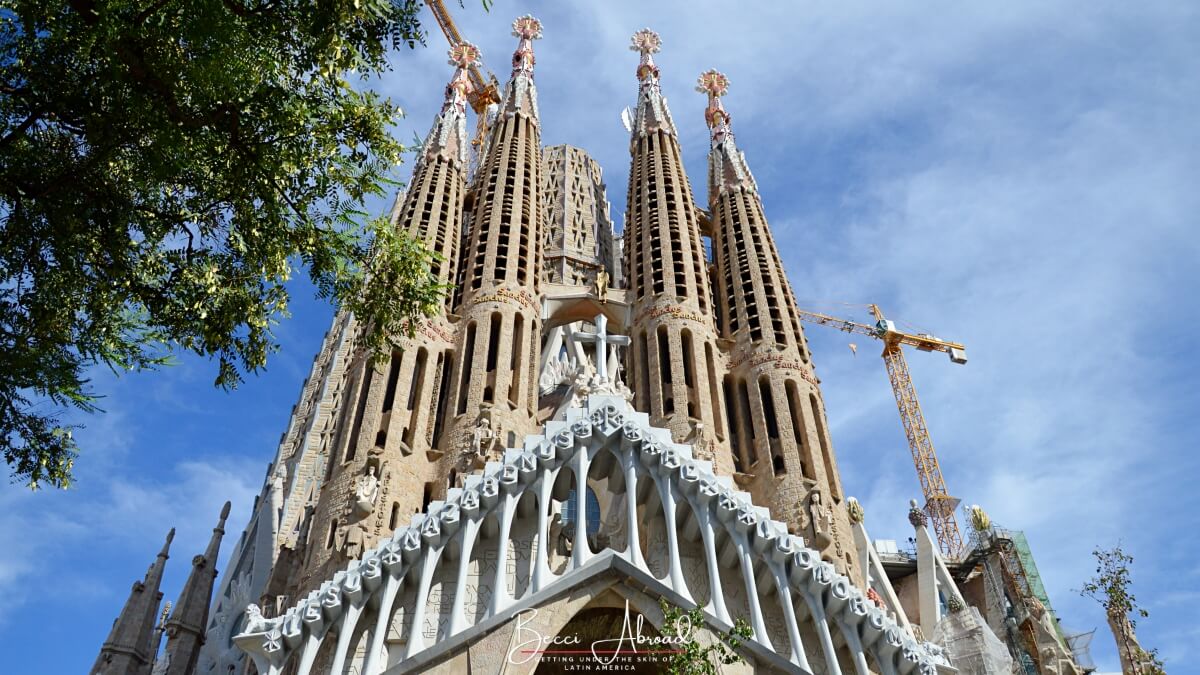


Park Güell
Park Güell is one of the absolute most popular places to visit in Barcelona, and an iconic landmark of the city!
The impressive Park Güell is designed by no other than Barcelona’s most famous architect, Antoni Gaudi, and overlooks the city from a hillside in the popular Gracia neighborhood.
As you explore more of the architecture in Barcelona, you will properly start to recognize Gaudi’s style with colorful mosaics, fairytale-like creatures, and curving stone structures.
And Park Güell is no exception!
Upon entering, you will see a staircase adorned with vibrant mosaics and sculptures. Further up, you will find balconies covered in colorful mosaic tiles, providing a panoramic view of Barcelona City and the Sagrada Familia.
In 1984, Park Güell was declared a UNESCO World Heritage Site. When visiting, don’t miss out on exploring other parts of the park, where you can enjoy beautiful houses, stunning views of the Barcelona City skyline, and a tranquil atmosphere away from the city.
For a stress-free and smooth visit to Park Güell, it is recommended to purchase your tickets in advance! Mostly the park sells out for same-day visits. Purchasing the tickets a few days ahead of time you should be fine.
Read my complete travel guide to Park Güell for all you need to know before visiting!


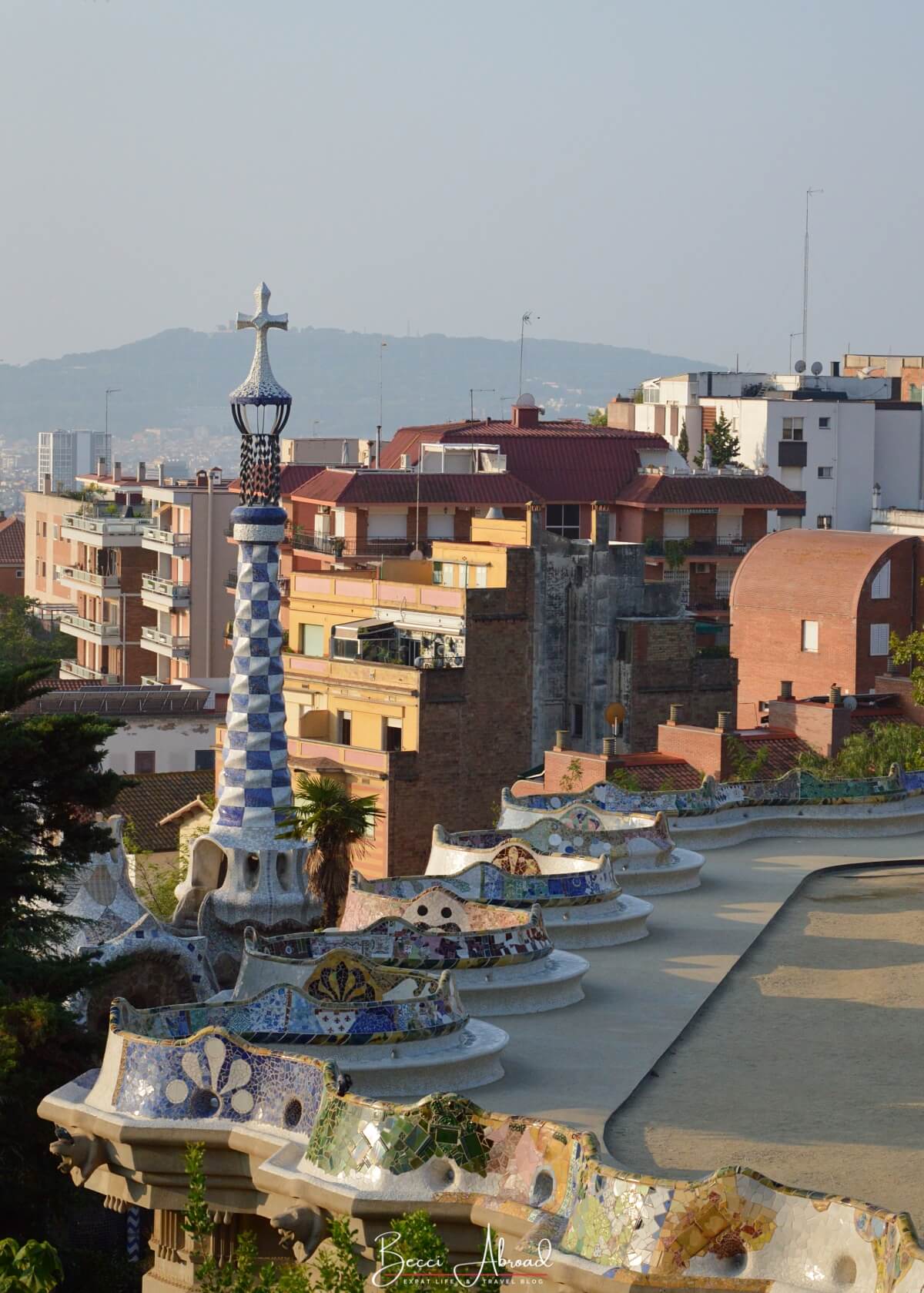
Casa Batlló
Casa Batlló is one of Antoni Gaudí’s most spectacular works, and truly one of the most popular places to visit in Barcelona!
Casa Batlló is considered one of the most iconic modernist buildings in Barcelona, featuring the essence of Catalan modernism with curvy and colourful details everywhere. Catalan modernism is all about replicating nature’s forms and colours in the architecture.
The most iconic part of Casa Batlló is the building’s facade. From top to bottom, the facade is covered in blue-toned mosaics with curvy windows and balconies. From the roof, you can see a dragon-like tail peaking up.
The construction of Casa Batlló began in 1904 when Gaudí was contracted by a wealthy industrialist, Josep Batlló, to redesign the house for him and his family.
Gaudí used the most modern technology and techniques of his time to design a house where functionality, proper ventilation, and lighting are mixed with an exceptional design.
In 2021, Casa Batlló underwent a complete renewal, focused on using modern technology and embarking visitors on a journey through Gaudí’s creative and innovative world. As a result of the renewal efforts, in 2022, Casa Batlló was awarded Europe’s Best Immersive Experience.
Casa Batlló is hard to overlook with its central location on the iconic Passeig de Gràcia shopping street, its colorful mosaic facade, and the endless line of eager visitors waiting to visit the inside of Casa Battló.
Casa Batlló is one of the most visited Gaudí buildings in Barcelona, with more than two million visitors every year. So, to get the best experience of this iconic Barcelona landmark, it is recommended to book tickets early in the morning to beat the crowds.
Tickets to visit Casa Batlló start at 36 euros for adults, and children under 12 can enter for free, making it a great option if you are travelling with kids.
Another option for learning about Gaudí and modernist architecture in Barcelona is to sign up for a Modernism walking tour.


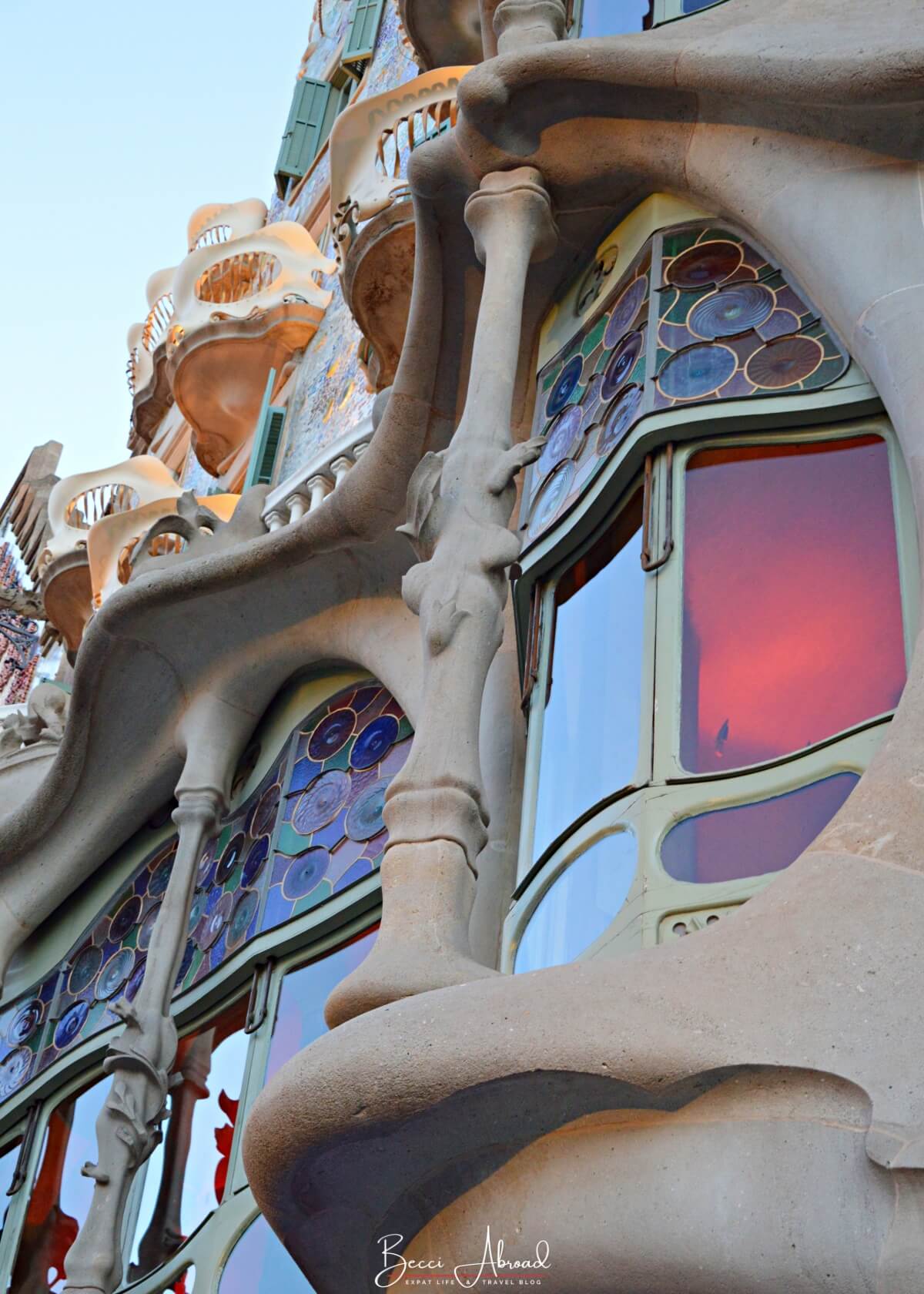
The Gothic Quarter & the Barcelona Cathedral
Barcelona’s Gothic Quarter is one of the most popular places to visit in Barcelona. The neighborhood features the oldest parts of Barcelona with narrow alleys and beautiful old churches.
The Gothic Quarter or Barri Gòtic in Catalan, used to be the city center of a Roman city. Some parts of the Gothic Quarter date back to over 2,000 years. You can visit the remaining of this Roman city at Barcelona’s Historic Museum, Museu d’Història de Barcelona (MUHBA).
The Gothic Quarter’s narrow pedestrian streets connected with small squares and surrounded by medieval buildings charm many people visiting.
However, the Gothic Quarter is also one of the most tourist areas of Barcelona City with souvenir shops lying side by side with restaurants and bars. It can be hard to move around the Gothic Quarter due to the crowds browsing around between the souvenir shops.
The crowdedness of the Gothic Quarter gives me mixed feelings about this part of Barcelona. If you want to truly appreciate the history that lies in these old narrow streets, consider signing up for a walking tour of the Gothic Quarter.
Popular Places to Visit in Barcelona’s Gothic Quarter
Barcelona Cathedral
The Catedral de la Santa Creu i Santa Eulàlia, or simply the Barcelona Cathedral is an impressive example of Gothic Catalan architecture. The construction of the Gothic Cathedral dates back to 1298. However, the cathedral we can admire today has undergone many changes over time. As an example, the main facade and bell tower date back to 1890, while the cathedral’s cloisters were built in the 14th century.
You can either admire the Gothic Cathedral from the outside or visit the Cathedral on the inside. With the entrance tickets, you can access the Cathedral’s rooftop terrace with a great view over the Gothic Quarter.
Pont Del Bisbe
The picturesque Neo-Gothic bridge, Pont del Bisbe (or the Bishop’s Bridge), is one of the most famous landmarks from Barcelona’s Gothic Quarter.
The bridge connects the Palau de la Generalitat, the palace for the Government of Catalonia, with the historic building, Casa dels Canonges, or the Canon House.
Kissing Lips Mural
A more contemporary contribution to the Gothic Quarter is the mural of the kissing lips located at Plaça d’Isidre Nonell, in front of the Cathedral.
The mural is a photo mosaic that from afar creates a pair of kissing lips. However, as you get closer you can see how each mosaic tile is a photo with its own story.
Plaça Sant Jaume
In the center of Barcelona’s Gothic Quarter, you will find the square Plaça Sant Jaume. Since the ancient Roman city of Barcelona in the 14th century, this square has been the meeting place for the political powers of the city.
Today, you can find Barcelona’s town hall, Casa de la Ciutat, and the palace for the Government of Catalonia, Palau de la Generalitat, located at Saint Jaume Square.
Basilica of Santa Maria del Pi
The Basilica of Santa Maria del Pi dates back to the 13th century and is another great example of Catalan Gothic architecture. The church is nestled between two squares in the Gothic Quarter, Plaça del Pi and Plaça Sant Josep Oriol.
Basilica of Santa Maria del Mar
The Basilica of Santa Maria del Mar translates as Our Lady of the Sea. The church is one of Barcelona’s finest and purest examples of Catalan Gothic churches and dates back to the 13th century.
La Rambla
La Rambla is the most famous street in Barcelona and a place you have to add to your Barcelona itinerary. The bustling pedestrian street can be found in the city center and is one of the most popular places to visit in Barcelona for first-timers.
La Rambla runs from Plaça de Catalunya towards the Barcelona promenade and Barceloneta Beach.
On one side of La Rambla, you have Barcelona’s historic Gothic Quarter with its narrow streets and historic buildings. On the other side of La Rambla, you will find the newer Eixample neighborhood with its gorgeous tall art nouveau buildings.
On La Rambla, a wide variety of shops, restaurants, and cafes are lined up side by side with street performers fighting to catch the attention of the many bypassers.
Honestly, La Ramba is one of my least favorite places in Barcelona. But it has become an extremely popular place to visit in Barcelona.
The Boqueria Market
The Boqueria Market is a true classic for everybody visiting Barcelona. The colorful food market is located just off La Rambla in the very center of Barcelona City.
The iconic Boqueria Market offers a wide range of fresh fruit and vegetables, seafood, meats, and other local delicacies. The market has been around since the 12th century and has become a must-see destination for tourists visiting Barcelona.
Most neighborhoods in Barcelona have their own local food market frequently used by locals. However, the Boqueria Market is one of the most well-known and visited markets in Barcelona.
If you want a local experience of the Boqueria Market, you can join this paella cooking class which will take you shopping at the market.

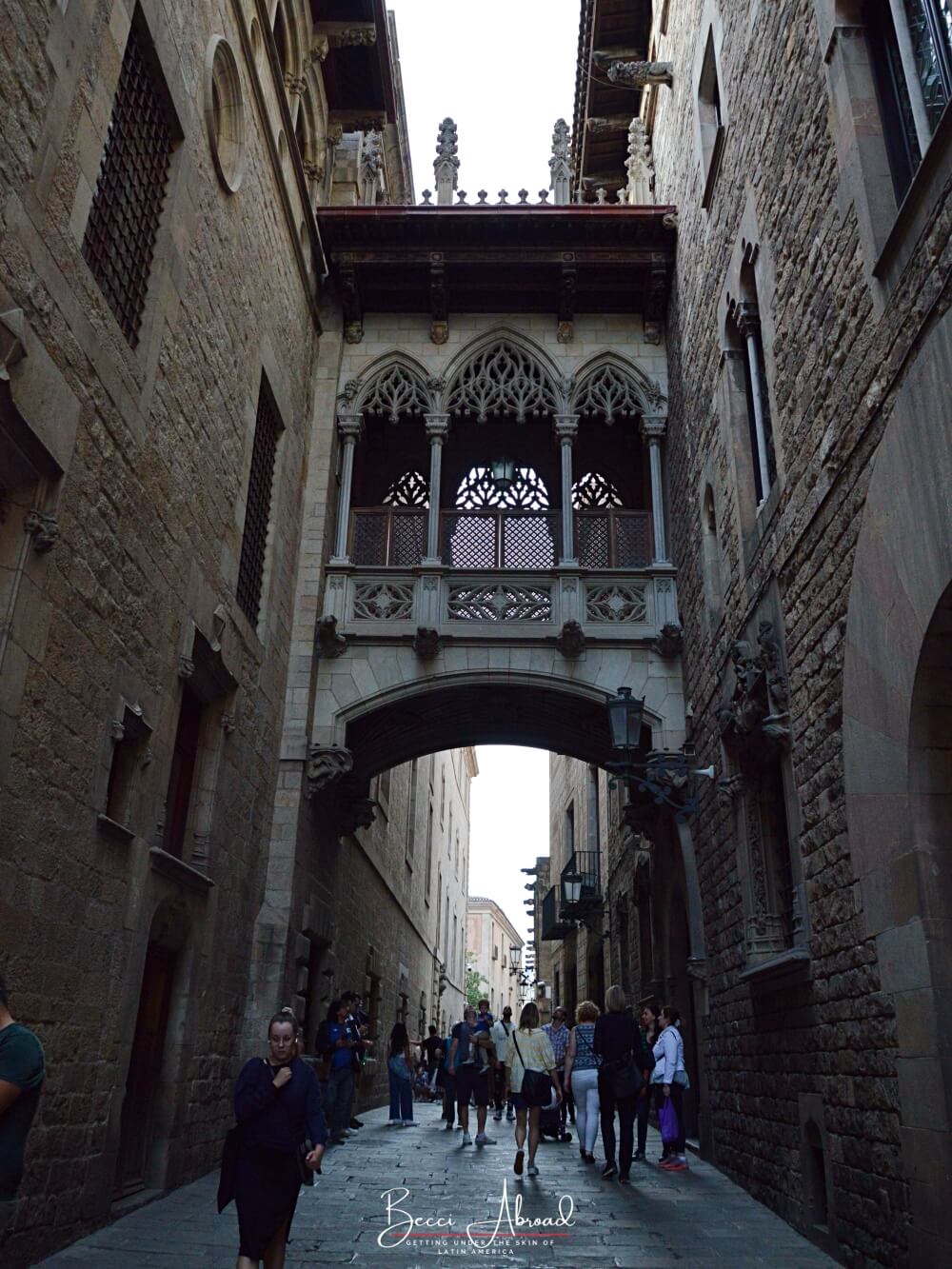

Plaça de Catalunya
Plaça de Catalunya is one of the most iconic and central squares in the city center of Barcelona. The square serves as a major transportation hub, connecting the old city with the newer Eixample neighborhood.
Plaça de Catalunya is a hotspot in Barcelona, surrounded by beautiful architecture, shops, restaurants, and cafes. At all times of the day, Plaça de Catalunya seems to be busy with people coming and going, meeting and greeting.
From Plaça de Catalunya, you can easily explore other parts of Barcelona on foot or by public transportation.
Many of the metro lines in Barcelona stop at Plaça de Catalunya making it an ideal starting point for exploring Barcelona.
Passeig de Gràcia
Passeig de Gràcia is one of the most iconic and famous avenues in Barcelona. A visit to Barcelona isn’t complete without a visit to Passeig de Gràcia!
The iconic Passeig de Gràcia is home to some of Barcelona’s most stunning buildings, designed by renowned architects such as Antoni Gaudí.
On Passeig de Gràcia, you can experience Casa Batlló and Casa Milà, two of the iconic Catalan Art Nouveau-style masterpieces designed by Gaudí.
However, the architecture featured at Passeig de Gràcia doesn’t stop at masterpieces by Gaudi. Strolling down Passeig de Gràcia, you can spot many other impressive buildings such as Casa Amatller (right next to Casa Batlló), Casa Lleó Morera, and Casa Malagrida – just to mention a few!
Passeig de Gràcia runs from Plaça de Catalunya to Avenida Diagonal. Apart from the gorgeous architecture, the avenue also features high-end shops alongside budget-friendly clothing stores such as H&M, Uniqlo, Mango, and plenty of restaurants and cafes.



Casa Milà (La Pedrera)
Casa Milà, also known as La Pedrera, is one of the most famous buildings in Barcelona, and a popular place to visit in the Catalan capital.
Casa Milà was designed by Antoni Gaudí at the beginning of the 19th century. The building was also Gaudi’s last private residence in Barcelona.
The construction of Casa Milà started in 1906 and was completed in 1910. The building’s unique curvy stone facade with iron balconies highlights Gaudi’s unique innovative style.
In 1984, Casa Milà became a UNESCO World Heritage Site with Park Güell, Palau Güell, and the Church of Colònia Güell.
Casa Milà is located on Passeig de Gracia, a few streets from another of Gaudi’s modernist masterpieces, Casa Batlló
You can visit the inside of Casa Milà where you can also get access to the building’s rooftop terrace with amazing views over Barcelona.
If you are short on time (or don’t want to spend yet another expensive entrance ticket), you can admire the facade from the outside or visit the cafe located on the building’s ground floor.
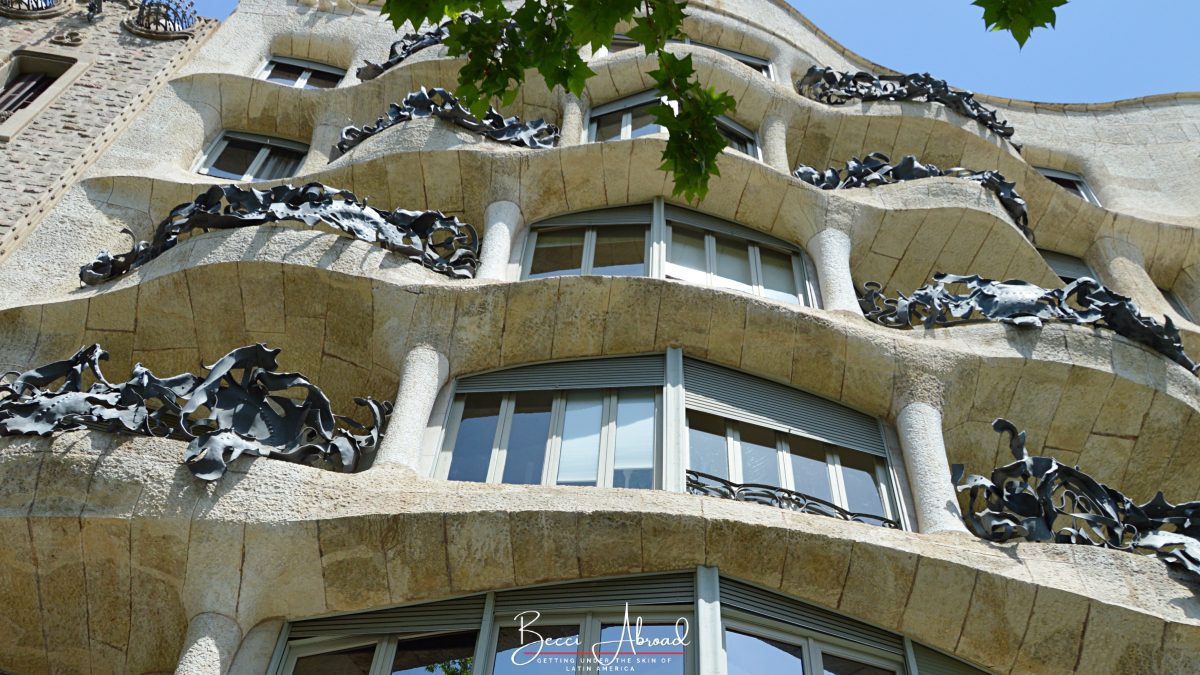
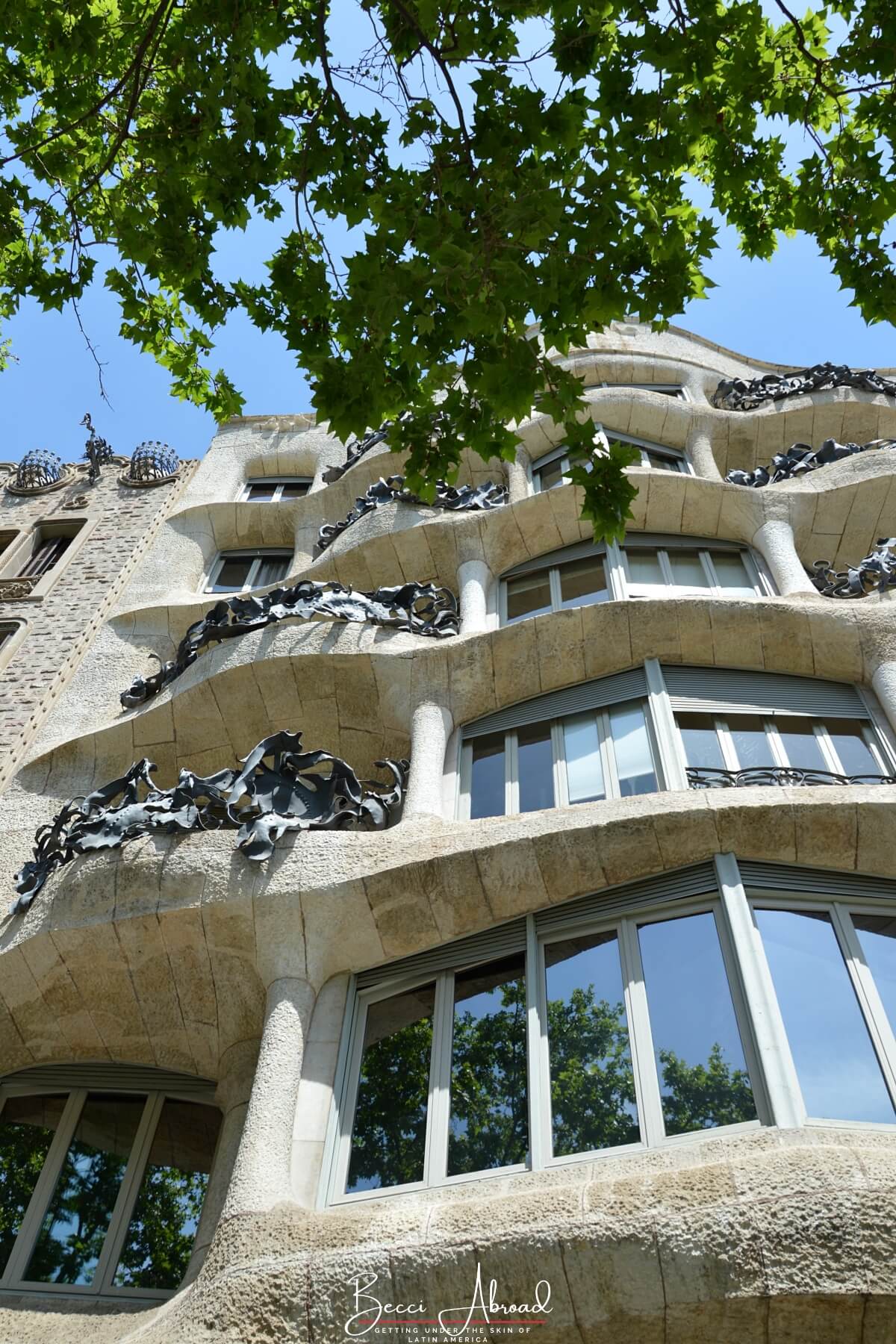

Palau de la Música Catalana
Palau de la Música Catalana, translated as the Palace of Catalan Music, is a stunning concert hall located in the historic quarter of Barcelona.
Palau de la Música Catalana is one of the most iconic and beautiful landmarks in Barcelona. It took me way too long to get to visit the building, and the experience was mindblowing when I finally did!
The concert hall was designed by Catalan architect Lluís Domènech i Montaner and built between 1905 and 1908. In 1997, Palau de la Música Catalana was declared a UNESCO World Heritage Site, and it is truly one of the most astonishing and popular things to do in Barcelona.
The building showcases the beauty of Catalan modernist architecture with stained glass windows, ornate columns, and colorful mosaics.
You can visit the Palau de la Música Catalana with a self-guided tour to learn more about its history and architecture or attend a concert to experience the acoustics firsthand.
Throughout the year, the Palau de la Música Catalana also hosts a variety of musical performances including classical music, opera, jazz, and flamenco. On their website, you can sometimes find tickets to an affordable price.
Picasso Museum of Barcelona
The Picasso Museum, Museu Picasso, is dedicated to showcasing the works of the legendary Spanish artist Pablo Picasso.
The Picasso Museum houses one of the most extensive collections of artworks by Picasso. The collection includes paintings, sculptures, ceramics, and sketches, and spans from Picasso’s early years to his later works.
The Picasso Museum is located in the heart of the Gothic Quarter within walking distance from Pont Del Bisbe. The museum’s location in a medieval mansion creates a unique setting for exploring the famous Spanish painter’s work.
For art lovers, the Picasso Museum is an absolute must-see attraction in Barcelona!
Barceloneta Beach
Barceloneta Beach is one of the most popular and well-known beaches in Barcelona. The beach is located in the neighborhood of the same name, Barceloneta.
Barceloneta Beach is close to the city center of Barcelona, which makes it easily accessible, and the sandy stretch of coastline attracts both locals and tourists alike.
On Barceloneta Beach, you can enjoy sunbathing, swimming, playing beach volleyball, taking a walk along the promenade, or sharing a glass of wine while looking at the Mediterranean Sea.
Barceloneta Beach is also home to various beach bars and restaurants where you can grab a refreshing drink or seafood dishes while enjoying the views of the sea.
In the summer, Barceloneta Beach is perfect if you are looking to add a more beach holiday feel to your Barcelona trip.
The Arc de Triomf de Barcelona
The Arc de Triomf is an iconic red brickwork monument located in the heart of Barcelona. The Triumphal Arch was designed by architect Josep Vilaseca i Casanovas as the main entrance to the 1888 Barcelona World Fair.
The Arc de Triomf stands at a height of 30 meters as the entrance to the promenade, Passeig de Lluís Companys.
The promenade leads from the Arc de Triomf to Ciutadella Park and is a popular place for street performers and musicians to perform.

Parc de la Ciutadella
Parc de la Ciutadella, translated as Ciutadella Park, is one of the largest and most popular green spaces in Barcelona. The Ciutadella Park is a popular place to visit for both locals and travelers looking for a peaceful retreat from the busy city life.
The beautiful park is located in the heart of Barcelona’s El Born neighborhood. Inside the Ciutadella Park, you can find several historic buildings, museums, the Barcelona Zoo, and the Parliament of Catalonia.
However, the most iconic feature of Ciutadella Park is the stunning Cascada Monumental, a grand waterfall designed by Josep Fontsere and dedicated to the city’s water supply. The huge white portal with the massive golden sculptures on top is hard to miss.
From the main entrance of the Ciutadella Park, you have a straight view of the Arco de Triomf.
During the weekends, especially in the summer, Ciutadella Park is a popular place for locals to meet to sunbathe, have a picnic on the grass, or rent a boat to row on the small lake located inside the park.



The Montjuïc Hill & Montjuïc Castle
Montjuïc Hill and the Montjuïc Castle are popular places to visit in Barcelona with stunning panoramic views of the city and the Mediterranean Sea.
The Montjuïc Hill is located in the southwestern part of Barcelona towards the Mediterranean Sea and overlooking the harbor of Barcelona. Its name, Montjuïc, translates to Jewish Mountain in old medieval Catalan language.
On the top of Montjuïc Hill, you will find the Montjuïc Castle, a historic fortress that dates back to the 17th century. The Montjuïc Castle was originally built as a military fortress to defend the city, it has since been repurposed into a popular tourist attraction in Barcelona.
On Montjuïc Hill, you can also visit the art museum of the famous Catalan artist, Joan Miró. The Joan Miro Foundation, or Fundació Joan Miró in Catalan, offers a vast collection of the artist’s bold and abstract paintings and sculptures.
If you are more interested in fine art, Montjuïc Hill also hosts the National Art Museum of Catalonia, Museu Nacional d’Art de Catalunya. The gorgeous museum overlooks Plaça d’Espanya at the foot of the Montjuïc.
In front of the museum, you will find the Magic Fountain of Montjuïc, which used to feature water and lighting shows. However, due to the extreme drought Catalonia is experiencing at the moment the fountain isn’t working.
Located next to the National Art Museum of Catalonia on Montjuïc Hill, you can experience an open-air architectural museum, called Poble Espanyol, or the Spanish Village. The village was built in 1929 for the Barcelona International Exposition to showcase the diversity of Spanish architecture. Learn more about Poble Espanyol.
Don’t miss the opportunity to take a cable car ride from Montjuïc Hill down to the beach for an unforgettable experience and breathtaking views of the city.
Tibidabo Mountain
The Tibidabo Mountain is one of the most popular places to visit in Barcelona if you are looking for breathtaking panoramic views of Barcelona city and the Mediterranean Sea.
Tibidabo Mountain is the highest peak in the Collserola mountain range, located 512 meters above sea level. From Barcelona, you can easily identify Tibidado Mountain; simply look for the mountaintop with the large church out on the horizon!
The church on top of Tibidado Mountain is called Temple Expiatori del Sagrat Cor. The entrance to the church is free.
The main attraction on Tibidabo Mountain is the Tibidabo Amusement Park. The amusement park is one of the oldest theme parks in Europe, dating back to 1899.
The theme park features vintage carousels and a Ferris wheel with stunning views of Barcelona. The Tibidabo Amusement Park is the perfect place to visit in Barcelona if you are traveling with kids!
The surrounding area of the Collserola Natural Park is also great for outdoor activities with many hiking trails and picnic areas.
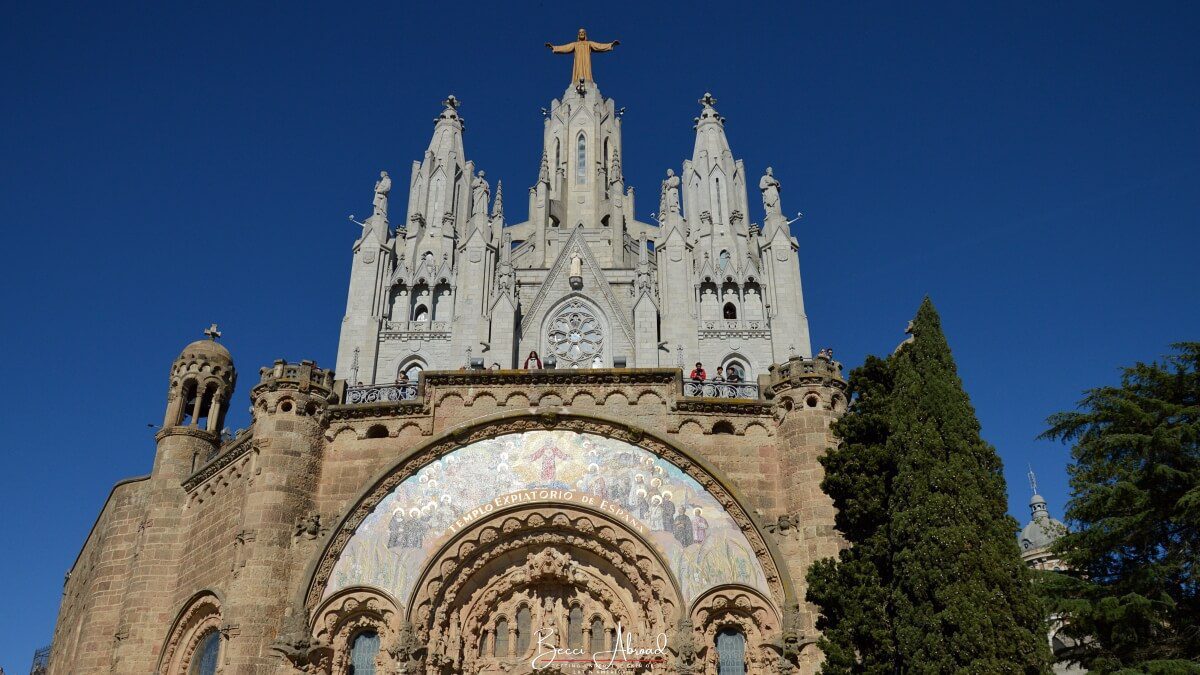

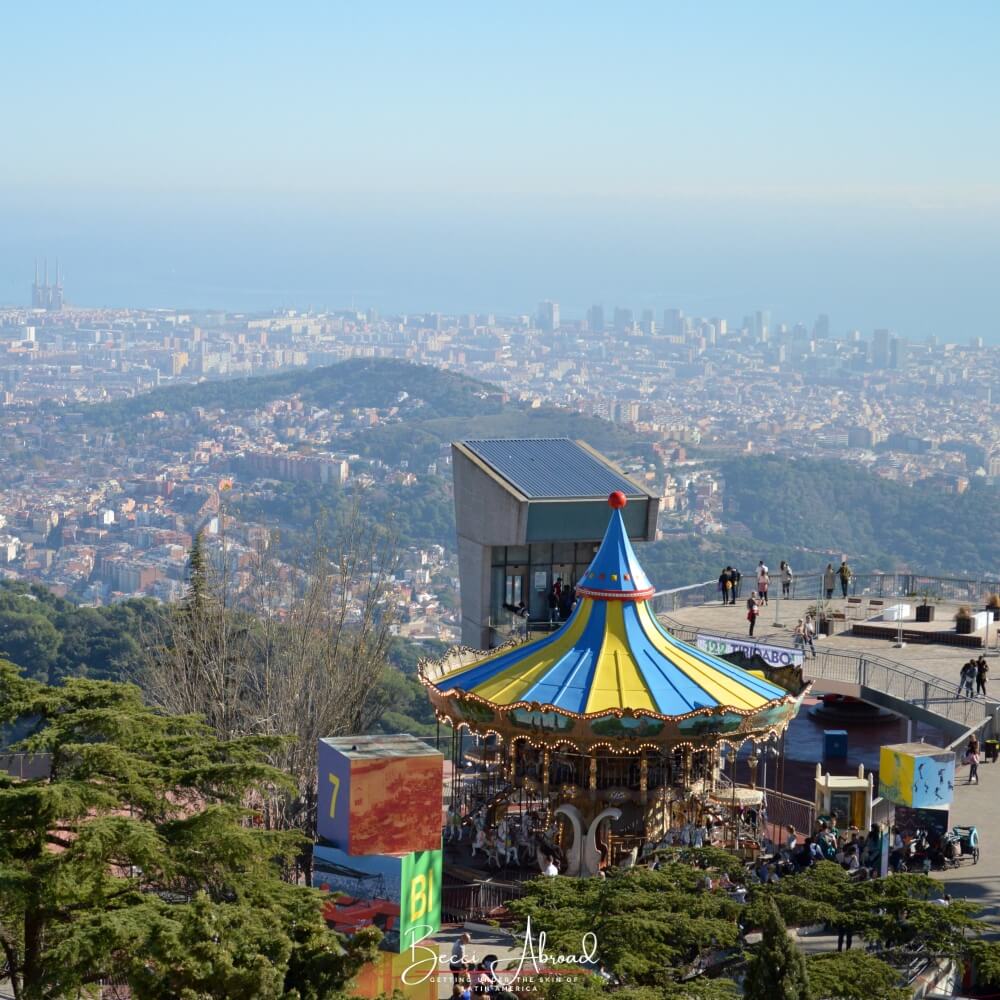
Casa Vicens
Casa Vicens is a stunning architectural gem located in the Gracia neighborhood of Barcelona. The house was Antoni Gaudí’s first major project in Barcelona and is considered to mark the beginning of his successful career as a modernist architect.
Casa Vicens is one of the most popular places to visit in Barcelona for everyone interested in Catalan art nouveau-style architecture.
The facade of Casa Vicens is an eye-catching color splash with multi-colored titles with flower motives and intricate ironwork that reflect Gaudí’s love for nature and his use of organic shapes in his designs.
The house was built between 1883 and 1888 as a private residence for Manuel Vicens i Montaner, a wealthy local merchant. At the time of the construction, the mansion was located freely in the middle of a large garden of what is now the busy Gracia neighborhood.
Originally, the house also included a waterfall in the surrounding garden. However, over the years the land around Casa Vicens got sold off, and today, we can only see a small part of the garden that used to surround the house.
Casa Vicens was declared a UNESCO World Heritage Site in 2005, and the house is not converted into a museum open to the public to visit. As with the most popular places to visit in Barcelona, it is a good idea to reserve your visit to Casa Vicens beforehand.

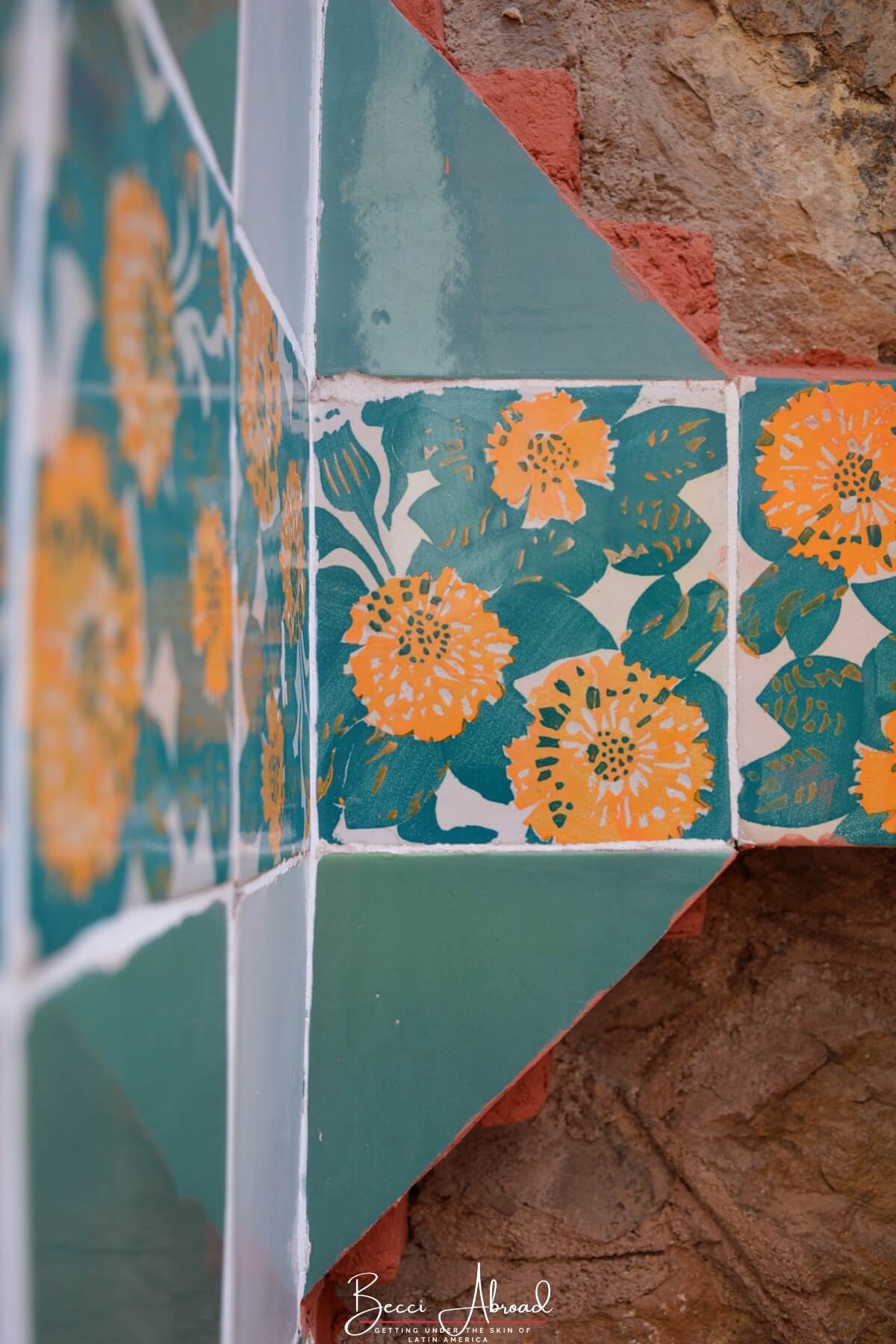

Day Trip to Montserrat Monastery
A day trip to Montserrat is a unique experience to explore the beautiful Catalan countryside outside Barcelona City.
The Montserrat Monastery is located on the mountaintop of a stunningly beautiful mountain range of the same name. From the Montserrat Mountains, you have breathtaking views of the surrounding Catalan countryside.
The monastery, known as Santa Maria de Montserrat, is home to the famous Black Madonna statue, a revered icon in Catalonia. In the area surrounding the Montserrat Monastery, you can also explore a local art museum and different hikes in the surrounding mountains.
Montserrat is a popular day trip from Barcelona, located only about an hour and a half outside of the city. You can easily reach Montserrat by train from Plaça d’Espanya. To get from the train station to the Montserrat Monastery, you can either take the cable car or a funicular railway up the mountain.
Montserrat is a must-visit destination for those looking to experience both natural beauty and religious history while in Barcelona.

Camp Nou – F.C. Barcelona Stadium
The Camp Nou Stadium is one of the most popular places to visit in Barcelona for any football fan!
The Camp Nou Stadium is the iconic home stadium of F.C. Barcelona, Barcelona’s famous football team. The stadium is one of the largest football stadiums in Europe, with a seating capacity of over 99,000 people.
The Camp Nou Stadium offers guided tours of the stadium to explore its various facilities and learn about the history of FC Barcelona. You can also stop by the FC Barcelona Museum located inside Camp Nou. The museum showcases the club’s history, trophies, and memorabilia.
The Torre Glòries Viewpoint
Torre Glòries is a prominent skyscraper in Barcelona’s skyline, serving as an iconic landmark and symbol of modern architecture in the city.
The Torre Glòries, previously named Torre Agbar, is a distinctive building in the Barcelona skyline because of its height, unusual shape, and colorful facade.
The round-scape skyscraper stands 144 meters tall in the middle of the Poblenou neighborhood and can be seen from most parts of Barcelona.
Torre Glòries was designed by architect Jean Nouvel, who is said to have been inspired by the shape of the Montserrat Mountains in his design of Torre Glòries. The construction of Torre Glòries began in 1999 and was finalized in 2004.
The top floor of Torre Glòries is a viewpoint offering panoramic views of Barcelona city and its surroundings.
While the views are amazing from the top, I was quite disappointed when visiting Torre Glòries since the glass construction on the outside blocks most of the beautiful views achieved from the viewpoint.
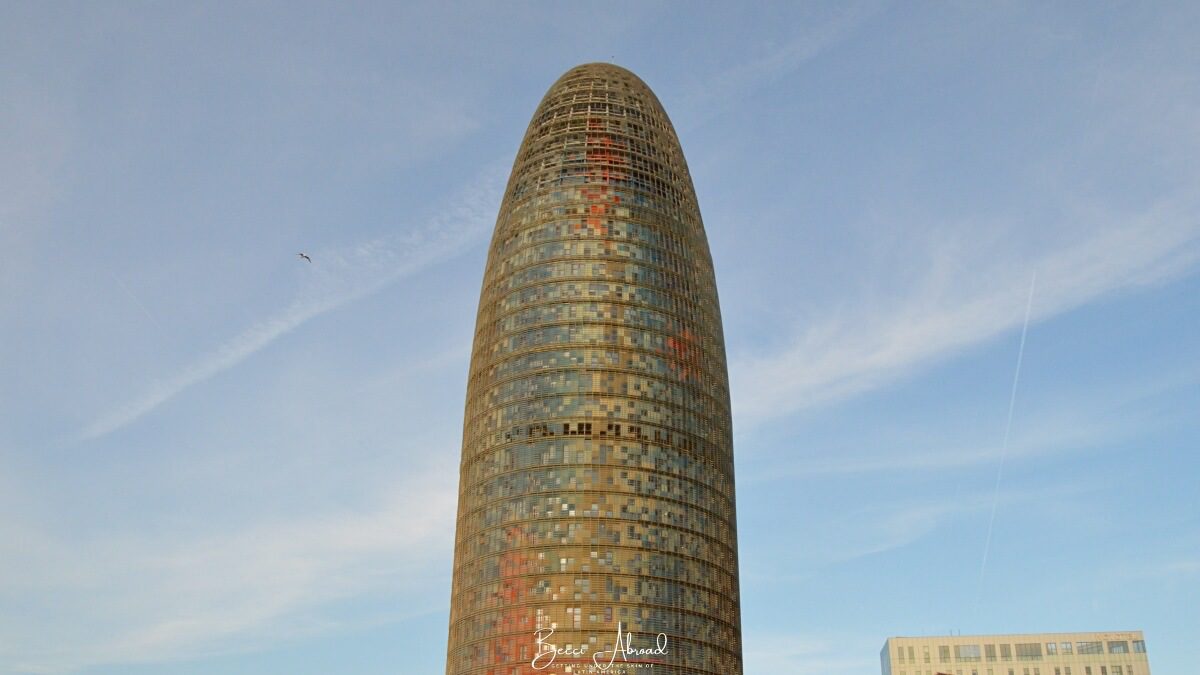

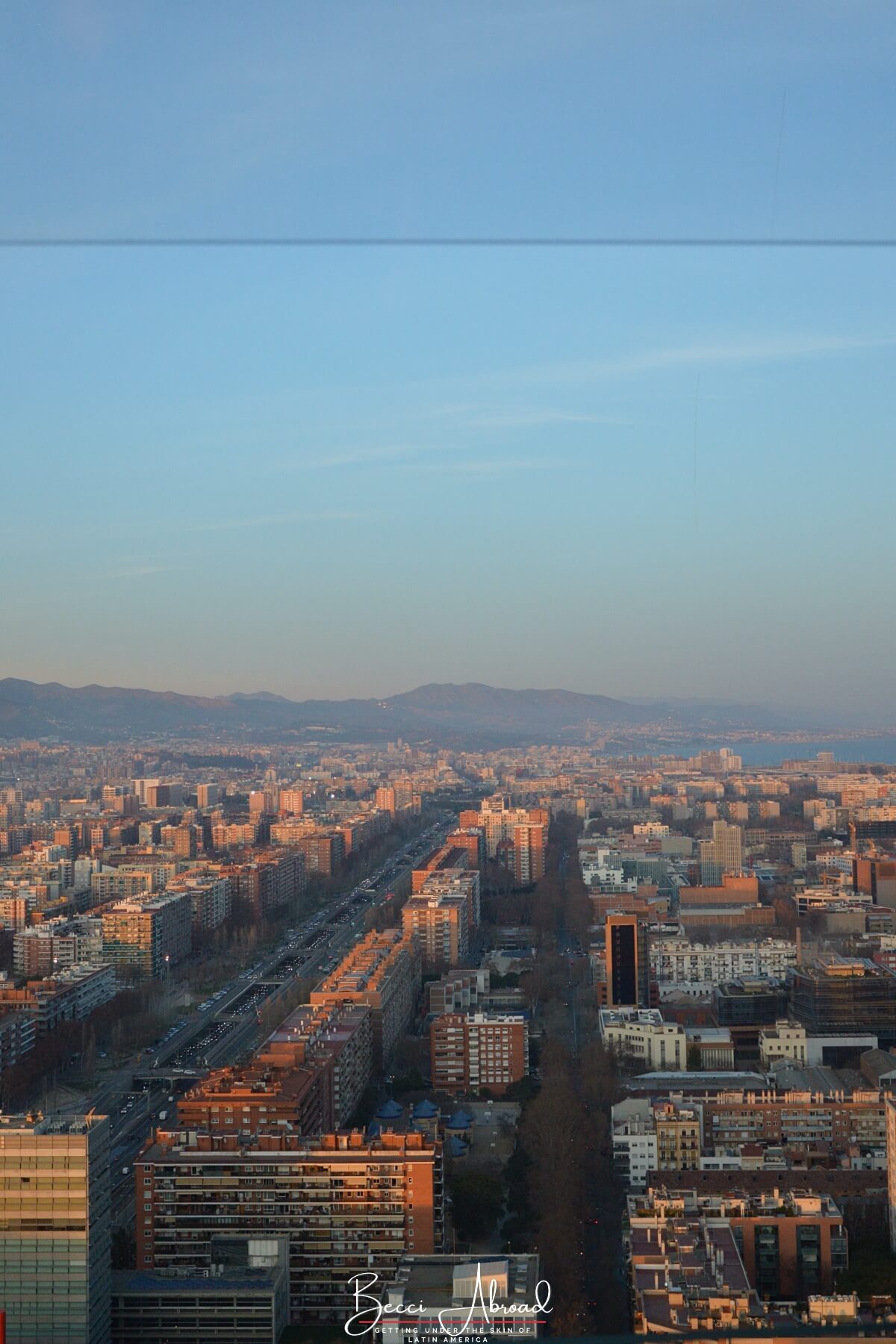
Final Thoughts: How Long Time Do You Need in Barcelona?
Barcelona is a city that continues to surprise and so many things to do and beautiful places to visit!
How long you need in Barcelona ultimately depends on your interests and how much you want to cover.
For exploring Barcelona’s popular places and iconic landmarks such as Sagrada Família, Park Güell, and the Gothic Quarter, enjoy the beaches, and taste Catalan cuisine, 3 to 4 days in Barcelona should be enough time.
However, if you want to explore a bit more and have the time available, consider spending 7 days exploring Barcelona.
Enjoy taking day trips from Barcelona to places like Montserrat, Girona, or Sitges, and explore some of Barcelona’s hidden gems.




